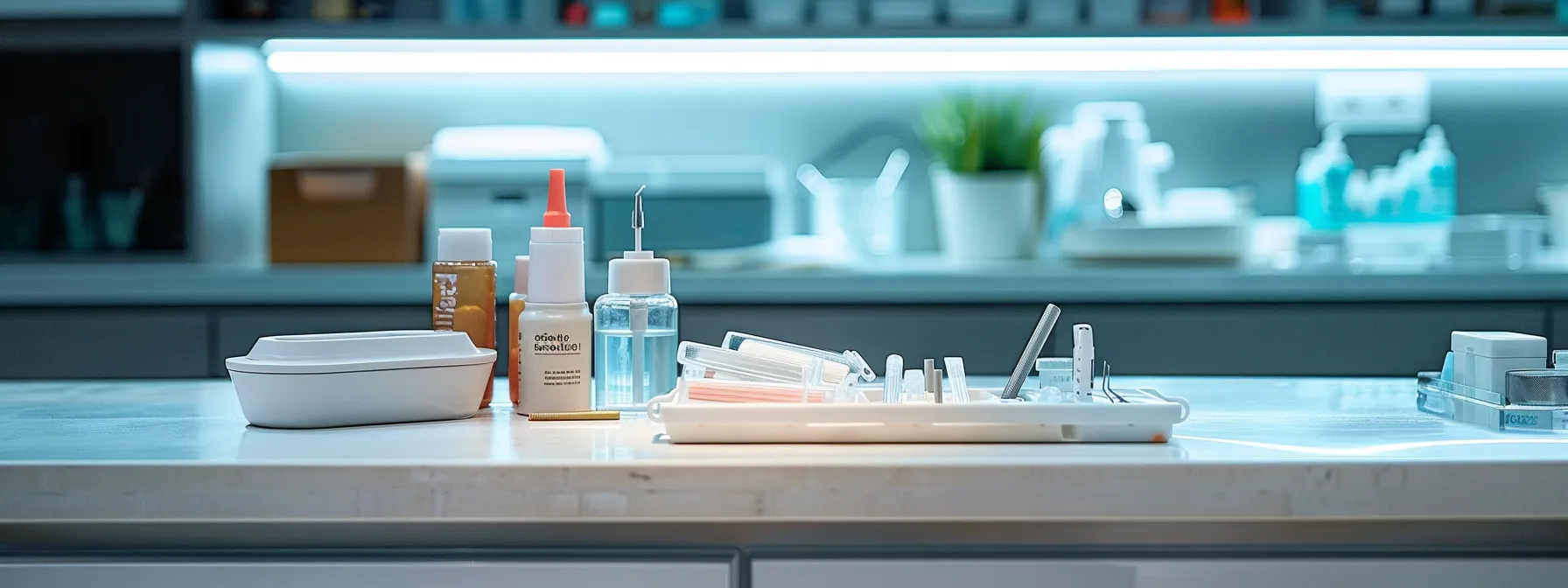Have you lost a filling or crown? Don’t panic. This quick guide will help you understand why it happened, what immediate steps to take, and how to find temporary solutions. You’ll learn about scheduling a dental appointment, treatment options, and post-appointment care. By following these steps, you can manage the situation effectively and prevent further complications until you see your dentist.
Key Takeaways
- Losing a filling or crown can be caused by decay, trauma, or wear and tear
- Recognizing symptoms early can prevent the need for more extensive dental procedures
- Temporary solutions like over-the-counter repair kits can provide relief until professional care is available
- Patients should communicate clearly with dentists about lost fillings or crowns for effective treatment
- Proper post-appointment care is crucial for optimal recovery after dental treatment
Understand the Reasons for Losing a Filling or Crown

Losing a filling or crown can happen for various reasons, from decay to trauma. This section explores common causes, symptoms of loose dental work, and when to seek immediate care from bosquecountydentist. Understanding these factors helps patients recognize issues early, potentially preventing the need for more extensive procedures like molar surgery.
Identify Common Causes of Crown or Filling Loss
Dental work can become loose or fall out due to various factors, including decay around the restoration, trauma to the tooth, or wear and tear over time. In states like Texas, where dental care access may vary, regular check-ups are crucial for maintaining oral health and preventing issues that could lead to the need for dental implants. Communities in these areas often benefit from local dental education programs that emphasize the importance of proper oral hygiene and early detection of potential problems with fillings or crowns.
Recognize Symptoms of a Loose Filling or Crown
Recognizing symptoms of a loose filling or crown is crucial for timely dental care. Patients may experience sensitivity to hot or cold, discomfort when biting down, or a visible gap between the restoration and the tooth. Individuals should be vigilant about these signs and seek professional help promptly. Dental offices often provide gauze and temporary solutions for patients experiencing crown or filling issues while awaiting therapy or more permanent treatment.
Learn When to Seek Immediate Dental Care
Patients should seek immediate dental care when experiencing severe pain, persistent bleeding, or signs of infection like swelling or fever. Dental offices often offer emergency appointment scheduling for urgent cases. Prompt action is crucial to prevent complications such as abscesses or the need for extensive procedures beyond routine teeth cleaning. Recognizing these warning signs helps individuals make informed decisions about their oral health:
- Severe, persistent pain
- Noticeable swelling in the gums or face
- Fever accompanied by dental discomfort
- Excessive bleeding from the affected area
- Difficulty breathing or swallowing
Assess Immediate Steps After Losing Your Filling or Crown

When a filling or crown is lost, quick action is crucial. This section outlines essential steps for immediate care, including gathering supplies for a temporary fix, managing pain safely, and preventing further damage until a dental appointment. These tips are especially helpful for Clifton residents focused on oral hygiene and tooth care, ensuring proper management of dental emergencies.
Gather Essential Supplies for Temporary Fix
When a filling or crown falls out, gathering essential supplies for a temporary fix is crucial. Patients can prepare by keeping dental cement, cotton swabs, and pain relievers on hand. These items help manage discomfort and protect the affected tooth from further decay until a dentist can provide proper treatment. In rural areas where dental access may be limited, having these supplies ready can be especially important:
Follow Safe Procedures to Manage Pain
When managing pain after losing a filling or crown, patients should follow safe procedures recommended by dental professionals. Over-the-counter pain relievers can help alleviate discomfort, while avoiding hot or cold foods can prevent sensitivity.
Dentists often advise patients to use a temporary filling material to protect the exposed tooth until they can receive proper treatment from a physician or dental specialist in Jersey.
Prevent Further Damage Until Your Appointment
To prevent further damage until a dental appointment, patients should avoid chewing on the affected side and maintain good oral hygiene. Patients can use dental wax to cover any sharp edges, protecting the tongue and cheeks. Dental networks often recommend rinsing with warm salt water to keep the area clean and reduce inflammation. Here’s a quick guide for temporary care:
Choose the Right Temporary Solutions for Your Case

When faced with a lost filling or crown, temporary solutions can provide relief until professional care is available. This section explores over-the-counter repair kits, dental adhesives, and temporary crown application techniques. For patients in South Dakota experiencing toothache, these methods offer interim relief. Dental assistants and doctors often recommend these approaches, especially when sedation dentistry isn’t immediately accessible.
Explore Over-the-Counter Dental Repair Kits
Over-the-counter dental repair kits offer a temporary solution for those who have lost a filling or crown. These kits, readily available in pharmacies, utilize advanced technology to provide accessible care, especially for those without immediate health insurance coverage. Dental professionals recommend these kits for short-term use, as they can help protect the exposed tooth and alleviate discomfort until a proper dental appointment can be scheduled:
- Temporary filling material
- Dental cement for reattaching crowns
- Applicator tools
- Pain-relieving gel
- Instructions for proper application
Use Temporary Dental Adhesives Carefully
Temporary dental adhesives offer a short-term solution for patients who have lost a crown. These adhesives, often made of porcelain-compatible materials, can securely hold a crown in place until a dentist can provide permanent treatment. Dental professionals recommend using these adhesives carefully, following instructions to ensure patient satisfaction and prevent further damage. When applying temporary adhesives, patients should:
- Clean the tooth and crown thoroughly
- Apply a thin layer of adhesive
- Carefully position the crown
- Bite down gently to secure
- Remove excess adhesive
Understand How to Apply a Temporary Crown
Applying a temporary crown is crucial for patients who have lost their original crown. Dental professionals recommend using patient portals to access instructions and video tutorials for proper application. In Clifton, where access to immediate dental care may be limited, patients can use temporary crown kits to protect their tooth until they can receive a permanent veneer or crown. The process typically involves cleaning the tooth, applying dental cement, and carefully placing the temporary crown:
Schedule a Dental Appointment Promptly

Scheduling a prompt dental appointment is crucial when a filling or crown is lost. Patients should learn to effectively communicate their situation to the dentist, ensuring proper care for their canal or mouth issues. Preparing questions about hygiene and treatment options helps maximize the visit’s value, leading to better oral health outcomes.
Learn How to Communicate Your Situation to the Dentist
When communicating with a dental office about a lost filling or crown, patients should clearly describe the issue, including when it occurred and any discomfort experienced. Many family dentistry practices offer cosmetic dentistry services, so patients should inquire about potential treatment options and associated fees. Providing detailed information helps the dental team prepare for the appointment, ensuring efficient and effective care.
Prepare Questions to Discuss During Your Visit
Patients should prepare questions about their oral health and treatment options before visiting their dentistry practitioner. Asking about potential causes of filling or crown loss can provide valuable feedback for future prevention. Inquiring about signs of infection, such as pus, ensures comprehensive care and helps patients understand their overall dental health status.
Understand Treatment Options for Replacing Fillings or Crowns
When replacing fillings or crowns, patients need to understand their options. This section explores different types of fillings and crowns, discussing their longevity and maintenance. A professional cosmetic dentist can guide patients through these choices, considering factors like cost and durability. Dental offices often provide payment plans to help manage expenses, ensuring patients receive the attention they need for optimal oral health.
Differentiate Between Types of Fillings and Crowns
Patients in Pennsylvania and Maryland can choose from various types of fillings and crowns based on their needs and budget. Cosmetic options like tooth-colored composite fillings or porcelain crowns offer aesthetic benefits, while metal fillings and crowns provide durability. Dental offices often discuss the pros and cons of each option, considering factors such as pain sensitivity and long-term wear. Patients should consult their dentist to determine the best choice for their specific situation, taking into account both function and appearance.
Discuss Longevity and Maintenance of Each Option
When discussing longevity and maintenance of filling and crown options, patients should consider factors like durability and potential for injury. Dental professionals often explain that composite fillings typically last 5-7 years, while metal fillings can endure up to 15 years with proper care.
Crowns, whether porcelain or metal, generally last 10-15 years but may require periodic adjustments, especially for patients undergoing orthodontics. Regular check-ups and good oral hygiene, including proper care of the gums, are essential for extending the life of any dental work. Patients with Medicaid should inquire about coverage for different treatment options and maintenance procedures.
Follow Post-Appointment Care for Optimal Recovery
After dental treatment for a lost filling or crown, proper post-appointment care is crucial for optimal recovery. Patients should implement best practices for oral hygiene and monitor for signs of complications. This care is especially important, where dental access may vary. Proper aftercare can help prevent issues like snoring or disease progression, ensuring long-term oral health even in remote areas like Alaska.
Implement Best Practices for Oral Hygiene After Treatment
After treatment for a lost filling or crown, patients should implement best practices for oral hygiene to ensure optimal recovery. Dr. Scott Kennedy, a renowned dentist in Clifton Texas, recommends gentle brushing around the treated area to maintain a healthy smile and prevent bleeding or tooth loss. Patients should use a soft-bristled toothbrush and lukewarm water to clean their teeth, paying extra attention to the gum line. Here’s a simple guide for post-treatment oral care:
Monitor for Any Signs of Complications After Dental Work
After dental work, patients should monitor for signs of complications, such as persistent pain, swelling, or fever. Dental clinics provide patients with information on what to expect during recovery, including normal symptoms and potential red flags.
Patients who experience severe pain, prolonged bleeding, or signs of infection should contact their dental surgeon promptly. Regular check-ups allow dentists to assess bone health and ensure proper healing after filling or crown replacement.
Conclusion
Losing a filling or crown requires prompt action to prevent further damage and alleviate discomfort. Understanding the causes, recognizing symptoms, and taking immediate steps for temporary relief are crucial for maintaining oral health until professional care is available.
Choosing appropriate temporary solutions and scheduling a timely dental appointment are essential steps in addressing the issue effectively. By following proper post-treatment care and staying vigilant for complications, patients can ensure optimal recovery and long-term dental health, emphasizing the importance of proactive dental care and regular check-ups.
Dr. Scott Kennedy and the team at Dynamic Family Dentistry are here to help you achieve the bright, confident smile you’ve always wanted. Book a consultation today to learn more about dental emergencies in Clifton, TX, and take the first step toward a radiant smile!
Schedule an Appointment
Dynamic Family Dentistry
302 S. Avenue Q, Clifton, Texas
Phone: (254) 675-3518
Related Articles
Dental Emergency, Understanding Emergency Root Canals, Emergency Extractions, Protection During Dental Emergencies, Lost a Filling or Crown Tips, What’s an Emergency Dentist


